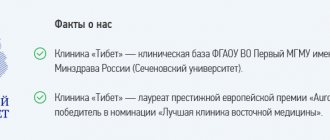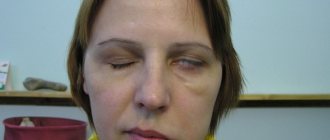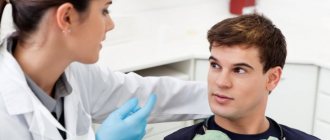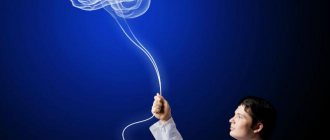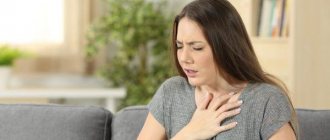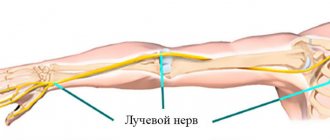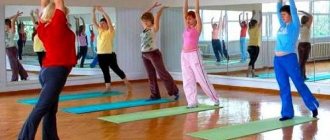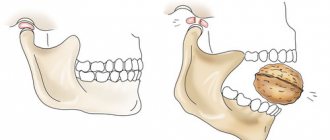Facial neuritis is a disease in which inflammation of one or more nerve fibers occurs. It can occur for many reasons, but most often it happens as a result of infectious processes of viral or bacterial etiology.
The essence of treatment in this case is to eliminate the causative agent of the pathological process and relieve pain. However, in order to fully recover, these measures are not enough. That is why neurologists strongly recommend that patients additionally engage in physical therapy (physical therapy).
This may include:
- massage;
- gymnastics aimed at strengthening muscle fibers;
- physical exercises to eliminate facial asymmetry;
- procedures performed using medical equipment (physiotherapy).
Regardless of how clearly the neuropathy manifests itself, exercise therapy in any case must go through the basic, main and residual stages. Contraindications to performing exercise therapy include:
- acute form of neuritis;
- early postoperative period;
- the presence of tumor processes in the affected area.
Gymnastics for neuritis of the facial nerve
Facial neuritis is an inflammatory lesion of the seventh pair of cranial nerves.
The facial nerve includes motor branches that innervate the facial muscles, and the intermediate nerve responsible for the innervation of the stapedius muscle, lacrimal gland, and taste sensitivity of the two anterior thirds of the tongue.
Typical symptoms of neuritis are pain behind the ear, weakness leading to a decrease or complete absence of facial movements, facial asymmetry, lacrimation, dry eyes, taste disorders. Other signs depend on the cause and location of the facial nerve lesion.
For a favorable course of the disease and restoration of the functions of facial muscles, long-term therapy is necessary, combining pharmacological and non-pharmacological methods. A mandatory component of the complex treatment of facial neuritis is gymnastics. In the article below we will discuss: the pros and cons of classes, features, whether preparation is needed before gymnastics, and we will consider some exercises.
The benefits and harms of gymnastics for the face for neuritis of the facial nerve
Therapeutic exercises are aimed at restoring the affected nerve trunk by normalizing its blood supply, increasing muscle strength, reducing paresis of the facial muscles, and relaxing the muscles on the healthy side.
Necessary for neuritis resulting from trauma, inflammation, pinching of the facial nerve of various origins.
Exercises are selected by a specialist in rehabilitation medicine or a neurologist individually, taking into account the severity of the process, the location of the lesion of the facial nerve, the severity of symptoms, and the presence of other treatment and rehabilitation measures.
There are contraindications when gymnastics can worsen the course of the underlying or concomitant disease. Classes are not prescribed in the acute period, for people with cancer, or for carpal tunnel syndrome.
Features of gymnastics
Facial gymnastics can be performed from the first days of the disease. At an early stage, classes are held under the guidance of a specialist who controls the exercise technique and the effort applied. In the future, possible independent training. Gymnastics are performed twice a day for 5-15 minutes until complete recovery.
While performing the exercises, it is important to concentrate, engage only the desired muscle group, avoiding friendly facial movements, and work for quality, not quantity. The healthy side of the face can be held with your hands so that the muscles are in a relaxed state.
The essence of therapeutic exercises is the measured tension/relaxation of individual muscles or muscle groups responsible for facial expressions and the pronunciation of certain labial sounds.
The training program includes exercises for facial muscles, tongue, lips, eyes, and improving articulation.
In order to recover in a shorter period of time, gymnastics is supplemented with acupressure of the face, neck-collar area, taping, applications of ozokerite, paraffin, and other physiotherapeutic procedures.
Preparation for the procedure
Experts advise performing facial massage or thermal procedures before starting gymnastics. Under the influence of heat, lymph and blood circulation increases, tissue metabolism improves, muscles relax, which increases the effectiveness of exercise.
The massage is performed by a specialist or independently, sitting/standing in front of a mirror. Using circular movements of the fingers, effortlessly massage the forehead, eye sockets from the inner corner of the eyes to the outer, then the parotid area, nose, area around the mouth, chin, and the front surface of the neck.
The gymnastics is completed by tilting the head forward, backward, to the sides, and circular rotations of the head.
In some cases, to improve the conductivity of the facial nerve on the affected side, a therapeutic effect of electric current with constant strength and low voltage is first performed.
Breathing exercises are important, especially for patients who have speech impairments. It has a beneficial effect on the entire body, normalizes lymph and blood supply, promotes the resorption of inflammation, restores nervous regulation, and increases the tone of the body. The most commonly used breathing exercises are Strelnikova, Buteyko, and Lobanova-Popova.
Set of exercises
Exercises for facial muscles:
- Wrinkle your forehead.
- Close eyes.
- Frown your eyebrows.
- Flare your nostrils.
- Puff out/pull in your cheeks.
- Smile at the corners of your mouth.
- Suck in air through your nose.
- Close your eyes one by one.
- Rinse your mouth with air.
- Pull your lips forward like a tube.
- Move your tongue left and right with your mouth open.
- Move air from one side of the mouth to the other.
- Whistle.
- Place your upper lip over your lower lip.
- Put out the match.
- With your mouth closed, move the tip of your tongue along the gums.
- Stick out your tongue and fold it into a “tube”.
- Rinse your mouth with water.
Eye exercises:
- Close your eyes.
- Squint your eyes.
- Alternately wink with your right and left eyes.
- Rotate your eyes from right to left.
- Extend your hand forward and touch your nose with your index finger. Repeat 5 times with each hand.
- Using your index, middle and ring fingers, press down on the closed eyelid without force. Repeat 5 times.
- Holding the skin in the area of the brow ridges with your index finger, slowly close your eyes, creating resistance. Number of exercises - 10 times.
- Rotate your eyeballs with your eyelids closed.
Tongue exercises:
- Raise your tongue to your upper lip and place it on your lower lip.
- Open your mouth, the tip of your tongue rests on your cheek, and makes up and down movements.
- Open your mouth, lift your tongue up, move the tips of your tongue across the palate from the upper teeth to the throat, and back.
- Lick your lips with your tongue, first clockwise, then counterclockwise.
- Open your mouth, use the tip of your tongue to brush behind your upper teeth, then behind your lower teeth.
- Smile, open your mouth, raise the tip of your tongue upward, strike forcefully behind your upper teeth, pronouncing the sound “d-d-d.” Perform for 10-20 seconds.
- Open your mouth, raise your tongue to your upper lip, bend it up, move it back and forth, saying “was-was-was.”
Exercises for the articulatory apparatus:
- Pronounce vowels: “o”, “u”, “i”.
- Pronounce consonant letters: “f”, “p”, “b”, “m”, “x”, “c”.
- Pronounce words in syllables with the letters listed.
Sources
- “Restoration of functional and trophic disorders in neuropathy of the facial nerve”, GN Khovanskaya, LA Pirogova, TA Novitskaya, NV Yurchevskaya, materials of the Republican scientific and practical conference with international participation, October 20, 2020.
- “Rehabilitation in neurology”, AV Epifanov, GEOTAR-Media, 2013 – 416 p.
- “Neuropathy of the facial nerve”, NA Igrunova, VA Kutashov, “Central Scientific Bulletin”, volume 1, number 2.
Diagnostic accuracy and quality service are the main priorities of our work.
We value every review our patients leave us.
Panina Valentina Viktorovna
Actress, Honored Artist of the RSFSR
I found out about you on the Internet - I urgently need an MRI.
And after the performance I’m with you. I really liked your staff. Thank you for your attention, kindness and accuracy.
May everything be as good in your soul as I am now, despite all the problems...
Be!!! We're happy! Your Panina V.V.
Open review scan
Array( [ID] => 107 [~ID] => 107 [CODE] => [~CODE] => [XML_ID] => 107 [~XML_ID] => 107 [NAME] => Panina Valentina Viktorovna [~NAME ] => Panina Valentina Viktorovna [TAGS] => [~TAGS] => [SORT] => 100 [~SORT] => 100 [PREVIEW_TEXT] =>
I found out about you on the Internet - I urgently need an MRI.
And after the performance I’m with you. I really liked your staff. Thank you for your attention, kindness and accuracy.
May everything be as good in your soul as I am now, despite all the problems...
Be!!! We're happy! Your Panina V.V.
[~PREVIEW_TEXT] =>
I found out about you on the Internet - I urgently need an MRI.
And after the performance I’m with you. I really liked your staff. Thank you for your attention, kindness and accuracy.
May everything be as good in your soul as I am now, despite all the problems...
Be!!! We're happy! Your Panina V.V.
Source: //cmrt.ru/stati/lechebnaya-gimnastika-lfk/gimnastika-pri-nevrite-litsevogo-nerva/
Recommendations for the patient
Before starting self-study, you must consult with a physical therapy instructor.
To prevent gymnastics from making your face asymmetrical, watch the duration of each movement: healthy muscles should perform fewer repetitions. To avoid unnecessary effort, you can sometimes cover the healthy side of your face with your palm.
Make sure that only those muscles for which it is designed participate in the exercise. If you tense your lips or tongue, your eyebrows should not wrinkle.
Don't try to do too much right away. Increase the load gradually so that the body does not receive additional stress.
Start the complex with a little self-massage. To do this, lightly rub your shoulders and neck so that you feel a surge of warmth in this area.
Then move on to the exercises:
- Pull your shoulders back so that your shoulder blades come together slightly. After this, begin to rotate forward, raising your shoulders up as much as possible. Finish the movement by bringing your shoulders forward and bringing them together slightly. Repeat 5-8 rotations forward, then backward.
- Tightening your shoulder muscles, sharply lift them as high as possible. Hold this position for a couple of seconds, then sharply relax your muscles. Repeat the exercise 4-5 more times.
- Straighten your back and begin to raise your arms, bringing your shoulder blades together. Your arms should rise to your shoulders and freeze in this position for a few seconds, then lower smoothly. Do this movement 6-8 more times.
- Place both hands on your right shoulder and apply gentle pressure. At the same time, pull your head in the opposite direction. Feel a slight stretch in your neck and shoulder muscles. Do the same on the other side.
- Cross your palms over your chest and apply a little pressure. Gently pull your chin up. Then place your hands on the back of your head and gently press down on your head so that your chin reaches toward your chest.
The entire complex must be repeated daily for 3-4 weeks. Then you need to track your progress and seek advice from a specialist who will help you adjust the complex depending on the results achieved.
Before facial gymnastics, it is also necessary to do self-massage. To do this, lightly stroking the entire surface of the face, starting from the lower part: chin, cheeks, nose, eyes and forehead, is sufficient. In this case, all movements should be performed from the center to the edge of the face.
For a massage, 2-3 minutes are enough, after which you can proceed to perform exercises, each of which must be repeated 5-10 times:
- frown and relax your forehead;
- alternately raise your right and left eyebrow. Then do this movement with both eyebrows at the same time;
- perform alternating winks with your right and left eyes;
- imagine that a mosquito has landed on your nose and you want to drive it away, but you cannot help yourself with your hands.
Move your nose, lips and other facial muscles so that the imaginary mosquito flies away. Repeat the exercise for 5-10 seconds, then take a short break; - To relieve tension, exhale forcefully through your mouth. In this case, the teeth should be clenched and the lips relaxed, so that they can quickly vibrate, making a hissing sound.
Before starting a gymnastics course, take a photo of your face. After 4 weeks of daily implementation of the complex, take a second photo.
After this, it is advisable to visit your doctor or exercise therapy instructor to receive recommendations and advice on further changes to the complex.
Sequencing:
- open your mouth and press your tongue as hard as you can against your right cheek, then against your left;
- open your jaw slightly, stick out your tongue a little and try to turn it sideways so that the right edge touches the upper jaw, and the left edge touches the lower jaw. Then turn your tongue the other way;
- Open your jaw and try to make a circular movement with your tongue so that it touches the front surface of your teeth. In this case, the lips must be kept closed. Start with 10 circles in each direction and gradually increase the number of repetitions to 50;
- try to touch your nose with your tongue, then your chin.
- pronounce the sound “prrrrr” with a long vibrating r for 5-10 seconds. Then take a break.
DETAILS: How and with what to treat inflammation of the trigeminal nerve on the face at home
Then you will need to consult a doctor who can assess your progress and give recommendations for further activities.
The disease imposes restrictions on lifestyle:
- do not overcool;
- speak little and quietly;
- eat in small portions, chew on both sides.
There are general rules for conducting therapeutic physical training for neuritis of the facial nerve:
- exercises are done in front of a mirror;
- each time those muscles that produce a certain movement must be involved. For example, when smiling you should not frown;
- You can first do the exercise mentally, then in practice.
The herpes virus is a common cause of damage to the facial nerve. It is necessary to treat herpes and other infections, as well as otitis (including non-infectious), caries, mumps.
Get your face back: therapeutic exercises for facial neuritis
Inflammation of the facial nerve makes it impossible to control emotions, that is, frown, smile, or raise eyebrows. The cranial region has 12 nerve pairs, the seventh pair, which is responsible for the facial muscles, is most susceptible to damage. The lesion is often one-sided, rarely spreading into two parts. The disease is quite common. The main reasons are determined:
- Transmission of an infectious disease: diphtheria, syphilis, borreliosis, etc.
- Disturbances in the functioning of the brain associated with problems with blood circulation.
- Hormonal disruptions, metabolic failure.
- Encephalitis tick bite.
- Congenital pathology associated with the anatomical features of the structure of nerves in a particular individual.
- Multiple sclerosis.
- Severe stress, depression.
- Formation of malignant/benign tumors.
- Incorrectly performed surgical intervention, plastic surgery aimed at improving the condition of the skin, its firmness and elasticity.
- Viral reactions: flu, colds, pneumonia.
- Ear problems: previous otitis media.
- Swelling.
- Diseases associated with connective tissue.
- Fractures, bruises in the temporal region.
Efficiency and recommendations for exercise therapy
Regular exercises give results after 2-3 sessions. Positive qualities are:
- Improving blood circulation in the affected area;
- Return to normal;
- Stimulation of biologically active points located;
- Normalization of the nervous system, facial and motor abilities;
- Calming, relaxing tense areas;
- Relieving inflammation.
The main recommendation is to wear a special corset. The measure helps speed up the recovery process. It is necessary to provide support for paralyzed muscles. It is used for one or two weeks at night. During the day it is necessary to massage for neuritis.
Early period of rehabilitation treatment
In the early period of rehabilitation treatment (days 1–10 of illness), positional treatment, massage and therapeutic exercises are used.
Position treatment is used to eliminate facial asymmetry and consists of adhesive plaster tension (taping) from the healthy side of the face to the affected side. It is directed against the pull of the muscles of the healthy side and is carried out by firmly fixing the other free end of the patch to a special helmet-mask, made individually for each patient from a bandage (see figure).
Taping rules:
- Correction of the muscles of the healthy side should be carried out with such force that the antagonist muscles of the affected side are sufficiently free in their actions and do not experience the pull of the muscles of the healthy side.
- The fixation of the free end of the patch to the helmet must be rigid (even double-folded) to keep healthy muscles in the correct position.
- Taping to reduce the palpebral fissure is carried out with one or two narrow strips of adhesive tape, which is attached to the skin of the eyelid in the middle of the palpebral fissure and gently stretched outward and upward, with the free end also attached to a fixed helmet. The narrower the palpebral fissure is when stretched, the easier it closes during involuntary blinking. In this way, the eye is naturally moistened with tears, which protects the cornea from drying out and ulceration.
- After the treatment session, you need to lubricate the skin areas to which the patch was attached with nourishing creams.
Recommendations for the patient:
- sleep on your side (affected side);
- chew food on both the affected and healthy sides;
- sit for 10–15 minutes 3–4 times a day with your head tilted towards the affected side, supporting it with the back of your hand (resting on your elbow);
- tie a scarf, pulling the muscles from the unaffected side to the affected side (from bottom to top), while trying to restore the symmetry of the face.
Treatment by position should be carried out during the daytime, when motor functions are most necessary for the patient to perform household, work and therapeutic activities. Taping to reduce the palpebral fissure, aimed not only at eliminating the muscle defect, but also at preserving the cornea, is also used at night, when it is especially important that the eye is completely closed.
Therapeutic gymnastics at this stage is carried out in small doses and is purely selective. The focus is on the muscles of the healthy side:
- dosed tension and relaxation of individual muscles and entire muscle groups;
- isolated tension (and relaxation) of those muscle groups that provide certain facial expressions (smile, laugh, etc.) or are actively involved in the articulation of certain labial sounds: [p], [b], [m], [v], [f] , [y], [o];
- minimal muscle tension, especially in the muscles surrounding the mouth.
All these exercises for the muscles of the unaffected side are of a preliminary, training nature and are aimed at preparing for effective exercise in the main period. A gymnastics session lasts 10–12 minutes and is repeated 2 times during the day.
Basic techniques
- Take the mirror;
- Using gentle movements, apply gentle pressure to the forehead;
- Look down;
- Close your eyes;
- Gently massage from the inner corner of the eye to the outer corner;
- We touch the nose with massage movements;
- We start from the wings, draw a line to the middle of the ear;
- We work on the lip area: lightly press the lips;
- Massage horizontally from chin to ear.
We invite you to familiarize yourself with What is enzyme peeling for the face?
We tilt our heads in opposite directions, then in a circle. We repeat the massage complex for neuritis 5-7 cycles per week. We do not allow pain.
Period of residual effects
During the period of residual effects (after 3 months from the onset of the disease), all types of exercise therapy used in the main period continue to be used, with an emphasis on therapeutic exercises, the task of which is to increase muscle activity to recreate maximum symmetry between the unaffected and affected sides of the face. During the same period, the training of muscle efforts in various facial situations increases.
According to summary global medical statistics, facial neuritis is observed in residents of various countries in approximately 2–3% of cases of all diseases of the peripheral nervous system, accounting for
from 16 to 25 cases per 100 thousand population.
complex facial neuritis nerve exercise
Source: //irinashatalova.ru/kompleks-uprazhneniy-nevrite-litsevogo-nerva/
Improved blood flow
Stroking or acupressure movements increase the patient's blood circulation of arterial blood, preventing it from stagnating in the veins, improving metabolic processes. They are also able to accelerate the breakdown of fat and protein products, so the inflammatory process is quickly eliminated, nerve conduction and tissue trophism are improved.
Exercise therapy for facial nerve paresis
Facial nerve damage is a fairly common diagnosis. The disease can affect a person at any age; it is important to consult a doctor as soon as possible and begin to follow the recommendations.
Introduction to the topic
Weakening of the muscles of one half of the face, the inability to control facial expressions, and perform chewing movements - all these are manifestations of neuropathy of the facial nerve. The nerve ending from the brain exits into the narrow ear canal, so any swelling or compression due to damage to the jaw can lead to unpleasant consequences.
The causes of the disease can be infectious diseases, bruises and damage to the temporal lobe, otitis media, viral diseases, and blood circulation disorders.
You can cope with the symptoms and prevent the consequences of such lesions with the help of exercise therapy of the facial nerve. A set of exercises is prescribed by the doctor, based on the area of the lesion and the reasons for the manifestation of such a symptom.
The benefits of exercise therapy for damage to the facial nerve
It is worth starting physical therapy for paresis of the facial nerve from the first days of illness in order to avoid paralysis and exacerbation of physical conditions.
Massage and a set of exercises for damaged facial muscles are the most important stages in restoring facial functions.
Exercise therapy treatment consists of three stages:
- the basic stage lasts up to 10 days, includes positional therapy;
- main – up to 3 months;
- residual – can last a lifetime.
In addition to performing gymnastics and physical exercises for neuritis, for inflammation you need to follow the recommendations:
- sleeping on the affected side;
- chewing food on both sides;
- sitting with your head tilted towards the affected area for 5 minutes several times a day (3-4 times), supporting your cheek with the back of your hand;
- tying the scarf so that the muscles on the unaffected side are pulled towards the affected side.
Contraindications
A contraindication to exercise therapy may be twitching of the affected side, involuntary muscle contractions in the corner of the eye.
In this case, treatment is prescribed only after consulting a neurologist.
Set of exercises
Exercise therapy in the early period for neuritis of the facial nerve is aimed at strengthening the muscles of the healthy side and stimulating the muscles on the affected side.
In the basic period, it is shown to tense and relax healthy muscles, work with facial tendons responsible for laughter, smiling, develop articulation, pronouncing the sounds [p], [b], [v], [f], [m], [o], [ y].
| A | ABOUT | U | AND | Y | |
| B | BA-BA, AB-AB | BO-BO, OB-OB | BU-BU, UB-UB | BI-BI, IB-IB | WOULD-WOULD, YB-YB |
| P | PA-PA, AP-AP | PO-PO, OP-OP | PU-PU, UP-UP | PEE-PEE, IP-IP | PY-PY, YP-YP |
| IN | VA-WA, AB-AV | VO-VO, OV-OV | VU-VU, UV-UV | VI-VI, IV-IV | YOU-YOU, YV-YV |
| F | FA-FA, AF-AF | FO-FO, OF-OF | FU-FU, UV-UV | FI-FI, IF-IF | FY-FY, YF-YF |
| M | MA-MA, AM-AM | MO-MO, OM-OM | MU-MU, UM-UM | MI-MI, IM-IM | WE-WE, YM-YM |
You need to exercise for 10 minutes 2 times a day.
The main stage of treatment of facial nerve paresis using exercise therapy consists of performing the following exercises:
- Frown and move your eyebrows up and down.
- With your eyes closed, perform circular movements with your eyeballs (holding the eyelid of the affected eye).
- Smile with a closed mouth.
- A smile with the mouth wide open, showing teeth.
- Squint and open your eyes wide.
- To frown.
- Exhale air with your head down, making “snorting” (vibrating) movements with your lips.
- Flare your nostrils.
- Perform movements as if whistling.
- Lift your upper lip up and lower your lower lip, exposing your teeth.
- Blow on a lit candle or match.
- Puff out your cheeks.
- Pull in your cheeks.
- Drive air from one part of the mouth to another.
- Puff out your cheeks and release air.
- Move the corners of your mouth down.
- Stick out your tongue.
- Roll your tongue into a tube.
- Move your tongue sticking out in different directions, left and right and back and forth.
- Make the mouth a tube or a “duck”.
- Follow with your eyes objects or a finger that moves in a circle in different directions.
- Place the upper part of the lips over the lower part.
- Move your tongue over your teeth and gums with your mouth closed.
Attention! In addition to exercise therapy exercises, you should try to pronounce groups of sounds: [o], [u], [i], [p], [v], [f], [oh], [pu], [vo], [fu], [ ko], [fi].
Main period of illness
During the main period of the disease (from the 10–12th day from the onset of the disease to 2–3 months), as a rule, restoration of the function of the affected muscles begins, but active treatment with exercise therapy must be continued.
Treatment with position Its duration increases to 4–6 hours a day, it alternates with exercise therapy and massage. The degree of tension of the adhesive plaster also increases, reaching hypercorrection - with a significant shift to the affected side, in order to achieve stretching and thereby weaken the strength of healthy muscles.
Therapeutic gymnastics It plays a leading role during this period. It is performed by the patient in front of a mirror with the participation of a physical therapy instructor and must be repeated by the patient (according to a shortened program) independently (2-3 times during the day). All exercises can be divided into several groups:
- differentiated tensions of individual muscles and muscle groups;
- dosed muscle tension, i.e. training them in a gradual contraction with increasing and decreasing strength;
- conscious inclusion of muscles and muscle groups in various facial situations - smiling, laughter, sadness, surprise, etc.;
- dosed tension during the articulation of various sounds, syllables, especially labial ones, requiring the participation of various muscle groups.
Special exercises for facial muscles:
- raise eyebrows;
- wrinkle your eyebrows (“frown”);
- close your eyes (the sequence of performing this exercise is: look down; close your eyes, holding the eyelid with your fingers on the affected side, and keep your eyes closed for a minute; open and close your eyes 3 times in a row);
- smile with your mouth closed;
- squint;
- lower your head down, take a breath and at the moment of exhalation “snort” (“vibrate” your lips);
- whistle;
- widen the nostrils;
- raise the upper lip, exposing the upper teeth;
- lower the lower lip, exposing the lower teeth;
- smile with your mouth open;
- extinguish a lit match;
- take water into your mouth, close your mouth and rinse it, trying not to throw out the water;
- puff out one's cheeks;
- move air from one half of the mouth to the other alternately;
- lower the corners of the mouth down with the mouth closed;
- stick out your tongue and make it narrow;
- open your mouth and move your tongue back and forth;
- opening your mouth, move your tongue left and right;
- stick your lips out like a tube;
- follow with your eyes the finger moving in a circle;
- suck in your cheeks with your mouth closed;
- lower the upper lip onto the lower one;
- move the tip of the tongue along the gums alternately in both directions with the mouth closed, pressing the tongue with varying degrees of force.
Exercises to improve articulation:
- pronounce sounds [o], [i], [u];
- pronounce the sounds [p], [f], [v], bringing the lower lip under the upper teeth;
- pronounce a combination of these sounds: [oh], [fu], [fi], etc.;
- pronounce words containing these sounds syllable by syllable (o-kosh-ko, Fek-la, i-zyum, pu-fik, Var-fo-lo-mei, i-vol-ga, etc.).
Self-massage of the face is useful
Do it 2-3 times a day, standing in front of the mirror.
— On the healthy side of your face, place your palm with your fingers up, closer to the auricle. For a paralyzed person - with the back side, fingers down, closer to the chin. Easily stretch healthy muscles down and towards the painful part of the face, and lift paralyzed muscles from the chin up.
- Close your eyes and press your eyelids with your middle fingers. For a minute, use light finger movements to stroke the orbicularis muscles of both eyes. Healthy - in the direction from top to outside, down, paralyzed - from bottom to top, from the nose to the eyebrow.
— Place the tips of your index fingers on the wings of your nose. Gently stroke the healthy side downwards and the paralyzed side upwards.
- Using circular movements of the index and middle fingers placed above the middle of the eyebrows, move the healthy muscle downward, towards the midline, lowering the eyebrow, and the paralyzed muscle upward, towards the midline, raising the eyebrow.
Therapeutic gymnastics
perform 2 times a day for 15-20 minutes, sitting in front of a mirror and focusing all your attention on the sore side of your face. Press the muscles of the healthy side with your palm - healthy muscles will always tighten. Repeat each exercise 6 times.
Treatment by position
A special treatment method, applied in the ward, is used to eliminate asymmetry of the facial structure. Taping is applied to the surface affected by neuritis: applying a patch to reduce muscle traction and hold the healthy part of the face in a natural position by fixing it on an individually designed helmet mask.
A session lasting up to six hours will allow you to:
- Improve movement of muscle tissue affected by neuropathy;
- Narrow the gap between the upper and lower eyelids, which ensures natural blinking and tear hydration of the eyeball.
The adhesive plaster is applied two to three times a day in the morning and afternoon to achieve maximum motor activity.
Prevention of neuropathy
Currently, no one is immune from the manifestation of unpleasant, painful symptoms of the disease. An inflammatory process, brain disease, and even simple hypothermia can cause the development of one of the forms of neuralgia: inflammation of the trigeminal nerve. If you want to avoid illness, you need to follow simple rules of a healthy lifestyle:
- Eat rationally and in a balanced manner.
- Exercise.
- Temper the body.
- Do not use air conditioning for a long time in hot weather.
- Avoid hypothermia and sudden temperature fluctuations.
You should also promptly contact your doctor to prescribe treatment for diseases of the throat, ear, and nose. During therapy, follow the doctor's recommendations, as well as bed rest.
Source: fb.ru
Standard
Typically, such a massage is performed by a specialist and does not last long - up to 20 minutes. However, classic massage for neuritis of the facial nerve is quite painful, so you will have to be patient during the recovery period.
The effects are aimed at improving blood flow to the facial muscles. It also restores reduced or lost motor functions due to the disease. Helps eliminate speech defects and relieves spasms of facial muscles.
Although this procedure is often performed by a specialist, it can also be done independently. However, before doing this, there are several important aspects to consider.
Execution Rules
It is recommended to massage twice a day and combine it with physical therapy exercises. For each of these actions, allocate about 10 minutes.
You must first study the detailed technique (if self-massage is performed).
The best way out is to perform several procedures in the presence of a specialist who will not only teach you how to perform it, but also monitor the correctness of the actions.
Initially, you need to stretch the muscles of the neck and face, and then proceed directly to performing certain techniques.
Exercise therapy for the neck before facial massage
In order to improve blood circulation in the head and neck area, immediately before the massage, it is necessary to carry out certain gymnastics (the so-called exercise therapy).
It is better to perform these exercises in front of a mirror so that the movements are symmetrical. After performing each movement, you should relax your muscles.
Initially, each movement should be done slowly in order to perform it correctly. After which you can move on to more active ones.
This course of exercises is aimed at the entire shoulder girdle. They spend it sitting on a chair.
- We move our hand to the side and turn our head in its direction, looking at the palm; repeat the same action with the other hand.
Place your hands on your shoulders and rotate your hands 5 times clockwise, then 5 times in the opposite direction.
Order and technique
Begin the massage from the frontal area:
- Horizontal strokes from the center to the temples.
- Vertical rubbing from the eyebrows to the hairline.
- Pressing with finger pads from the center to the temples; on the forehead, applying pressure with the entire length of the fingers.
- Alternately squeezing the skin with your thumb and index finger (pinching).
- Tapping your forehead with your fingertips.
Next, move on to massage the eye sockets:
- With your eyes closed, move your middle finger from the outer corner of the eye to the inner corner (along the lower orbit).
- Using your index finger, make pointed circular movements to the inner corner of the eye along the lower edge.
- We repeat the same movements above the eyebrow.
- We pinch our eyebrows.
- We stroke the eye sockets.
The next stage is massage of the lower part of the face (nose, lips, jaw):
- Using horizontal movements, rub from the middle of the chin to the nose, along the back of the nose.
- We apply point pressure on the chin and nasolabial triangle.
- We stroke with our palm from the middle of the chin to the nose, along the nose, from the tips of the lips to the sides.
- We perform pinching in the nasolabial triangle.
The final stage is a cheek massage:
- We stroke our cheeks with our palms.
- Rub from the nose to the edges of the cheeks.
- Circular point massage with fingers.
- We run our fingertips over our cheeks.
- We pinch the cheeks, grabbing the neck.
- Apply precise pressure with your fingertips.
- Tap with your fingertips.
- We tap our cheeks with our index and middle fingers.
- We stroke the nasolabial folds with our thumbs.
Each point must be repeated 2-3 times, while repeating the first point after each exercise.
Duration of exposure
The duration of each session does not exceed 20 minutes. On average – 5 minutes of preparation and 10 minutes of the massage itself.
The course is quite long and is divided into three stages:
Massage for neuritis of the facial nerve:
Symptoms
It is important to recognize facial neuritis in time so that measures can be taken. Not all people know exactly how this disease manifests itself. For this reason, they cannot diagnose it in time. It is important to familiarize yourself with the characteristic symptoms in order to recognize the disease in time.
Signs:
- Pain syndrome.
It may appear even before other signs of the disease appear. In this case, the pain first appears behind the ear, then spreads to half of the face. Often it can have a paroxysmal nature and occur with a certain frequency, for example, once every few hours. - Speech problems.
A person loses the ability to pronounce words clearly. It is especially difficult to pronounce sounds such as “p”, “v”, “f”. - Distortion of facial features.
One eye becomes wide open, the corner of the mouth may droop, and the nasolabial fold may smooth out. All these signs are especially visible in situations when a person begins to laugh or talk. - Dry mouth.
This happens in a situation where the innervation of the salivary gland is disrupted. Also, on the contrary, a person may suffer from excessive drooling from the drooping corner of the mouth. - Increased sensitivity to sounds.
It manifests itself precisely on the affected side, and is explained by the fact that the facial and auditory nerves are nearby. A person begins to feel that sounds are much louder than they really are. - Biting the affected cheek while chewing food.
Often people begin to suffer from the fact that food falls out of one corner of their mouth.
It should be noted that even from these symptoms one can easily guess what exactly one is dealing with. An experienced doctor will be able to immediately tell what kind of disease a person has.
In some cases, it is necessary to undergo a full diagnosis in order to determine the cause of the neuritis. In this case, it will be easier to understand what to do in such a situation.


